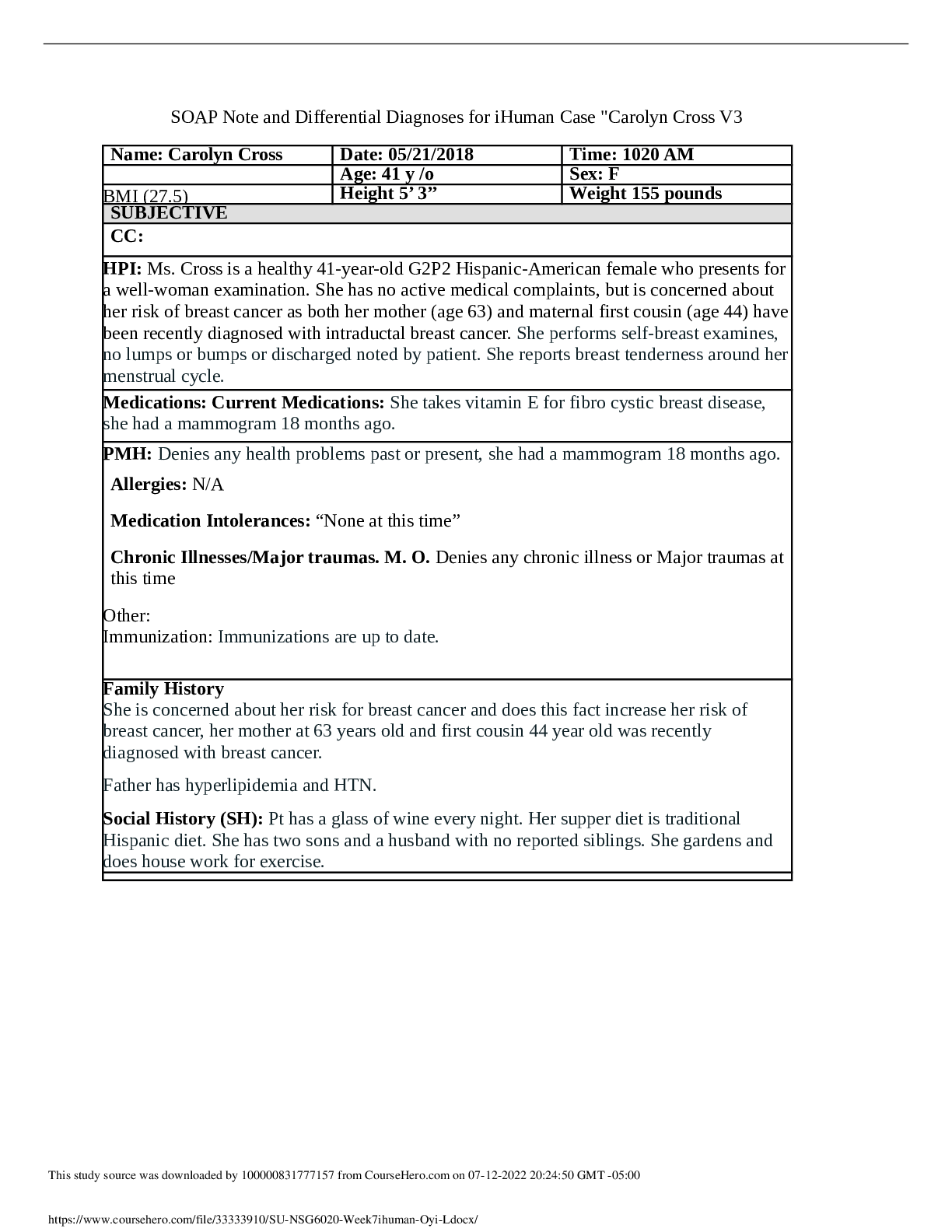Week 10-Pneumonia-COPD Unfolding Reasoning,100% CORRECT
Document Content and Description Below
Week 10-Pneumonia-COPD Unfolding Reasoning Avery Edward Pneumonia-COPD Joan Walker, 84 years old Primary Concept Gas Exchange Interrelated Concepts (In order of emphasis) ... 1. Infection 2. Acid-Base Balance 3. Thermoregulation 4. Clinical Judgment 5. Pain 6. Patient Education 7. Communication 8. Collaboration © 2016 Keith Rischer/www.KeithRN.com UNFOLDING Reasoning Case Study: STUDENT Pneumonia-COPD History of Present Problem: Joan Walker is an 84-year-old female who has had a productive cough of green phlegm that started four days ago that persists. She was started three days ago on prednisone 40 mg PO daily and azithromycin (Zithromax) 250 mg PO x5 days by her clinic physician. Though she has had intermittent chills, she had a fever last night of 102.0 F/38.9 C. She has had more difficulty breathing during the night and has been using her albuterol inhaler every 1-2 hours with no improvement so she called 9-1-1 and was brought to the emergency department (ED) where you are the nurse who will be responsible for her care. Personal/Social History: Joan was widowed six months ago after 64 years of marriage and resides in assisted living. She is a retired elementary school teacher. She called her pastor before coming to the ED and he has now arrived and came back with the patient. The nurse walked in the room when the pastor asked Joan if she would like to pray. The patient said to her pastor, “Yes please, I feel that this may the beginning of the end for me!” What data from the histories is RELEVANT and has clinical significance to the nurse? RELEVANT Data from Present Problem: Clinical Significance: Productive cough of green phlegm X4days Chill and fever overnight of 102. Difficulty of breathing overnightUse of inhaler q 1-2 hours no improvement This may be the start of pneumonia. Her high fever and chills may be a sign of infection. Her difficulty breathing could cause her to panic, not getting enough air is a scary situation to be in. Using the inhaler with no improvement should be of concern to the nurse. RELEVANT Data from Social History: Clinical Significance: Widowed, Lives in assisted living, Retired, Feeling of hopelessness due to her comment of “yes please, I feel like this may be the beginning of the end for me”! Her only support system is no longer by her side. Residing in assisted living is helpful, he can make new friends and enjoy social interaction. Sheis retired which means not as productive as she once was. She may not be getting outside as much or exercising as much. She sounds hopeless by her statement. She thinks she will not survive this hospital stay. What is the RELATIONSHIP of your patient’s past medical history (PMH) and current meds? (Which medication treats which condition? Draw lines to connect) PMH: Home Meds: Pharm. Classification: Expected Outcome: ∙ COPD/asthma ∙ Hypertension ∙ Hyperlipidemia ∙ Cor-pulmonale ∙ Anxiety ∙ 1ppd smoker x40 years; quit 10 years ago *What I highlighted in 1. Fluticasone/salmeterol diskus 1 puff every 12 hours 2. Albuterol MDI 2 puffs every 4 hours prn 3. Lisinopril 10 mg PO daily 4. Gemfribrozil 600 mg PO bid 5. Diazepam 2.5 mg PO every 6 hours as needed 6. Triamterene-HCTZ 1 tab PO daily 1. corticosteroid 2. bronchodilator 3. ACE inhibitor 4. cholesterol 5. Benzodiazepine 6. potassium sparing diuretic 1. improve breathing 2. open up airway in the lungs 3. decrease blood pressure and open up blood vessels 4. decrease fatty acids 5. decrease anxiety and calm down red is what I circled. 6. help body from not absorbing too much salt and keep potassium level from getting too low. One disease process often influences the development of other illnesses. Based on your knowledge of pathophysiology, (if applicable), which disease likely developed FIRST that created a “domino effect” in her life? ∙ Circle what PMH problem likely started FIRST ∙ Underline what PMH problem(s) FOLLOWED as domino(s) © 2016 Keith Rischer/www.KeithRN.com Patient Care Begins: Current VS: P-Q-R-S-T Pain Assessment (5th VS): T: 103.2 F/39.6 C (oral) Provoking/Palliative: Deep breath/Shallow breathing P: 110 (regular) Quality: Ache R: 30 (labored) Region/Radiation: Generalized over right side of chest with no radiation BP: 178/96 Severity: 3/10 O2 sat: 86% 6 liters n/c Timing: Intermittent–lasting a few seconds What VS data is RELEVANT and must be recognized as clinically significant by the nurse? RELEVANT VS Data: Clinical Significance: High temp This high temp could be a sign of infection. Pulse is also high which could be due to Pulse is infection, fever, or anxiety. Respirations are very high and O2 is very low this is a Resps main concern, she is not getting enough oxygen into her system and can become BP high hypoxic and go into resp acidosis. Blood pressure is elevated, and she has a history of O2 LOW despite being elevated BP and heart failure so BP mustbe monitored. Patient is in pain and seem to on 6 L per NC but is only stating 3/10 and achiness over the R side of chest. Breaths are deep and shallow Pain over R side of chest Current Assessment: GENERAL APPEARANCE: Appears anxious and in distress, barrel chest present RESP: Dyspnea with use of accessory muscles, breath sounds very diminished bilaterally ant/post with scattered expiratory wheezing CARDIAC: Pale, hot & dry, no edema, heart sounds regular–S1S2, pulses strong, equal with palpation at radial/pedal/post-tibial landmarks NEURO: Alert & oriented to person, place, time, and situation (x4) GI: Abdomen soft/non-tender, bowel sounds audible per auscultation in all 4 quadrants GU: Voiding without difficulty, urine clear/yellow SKIN: Skin integrity intact, skin turgor elastic, no tenting present What assessment data is RELEVANT and must be recognized as clinically significant by the nurse? RELEVANT Assessment Data: Clinical Significance: She is anxious and in distress Barrel chest is present She is using her accessory muscles to breath and has dyspnea. There is wheezing and diminished lung sounds BILAT Her general appearance is important because we can see that she is having difficulty breathing and is anxious. Her respiratory assessment is important because again we can see that she is in distress and having a possible COPD exacerbation. With the wheezing and diminished lungs sounds she is retaining fluid and her lungs are filling up. © 2016 Keith Rischer/www.KeithRN.com 12 Lead EKG Interpretation: Sinus tachy Clinical Significance: The fast HR is most likely DT the infection going on. Possible pneumonia. She could be dehydrated Chest x-ray: What diagnostic results are RELEVANT that must be recognized as clinically significant to the nurse? RELEVANT Results: Clinical Significance: Left lower lobe infiltrate. Hypoventilation present in both lung fields Possible pneumonia or even sepsis. The hypoventilation is most likely DT a COPD exacerbation. Lab Results: What lab results are RELEVANT that must be recognized as clinically significant to the nurse? Complete Blood Count (CBC) Current High/Low/WNL? Previous: WBC (4.5–11.0 mm 3) 14.5 High 8.2 Hgb (12–16 g/dL) 13.3 WNL 12.8 Platelets(150–450x 103/µl) 217 WNL 298 Neutrophil % (42–72) 92 High 75 Band forms (3–5%) 5 WNL 1 What lab results are RELEVANT that must be recognized as clinically significant to the nurse? RELEVANT Lab(s): Clinical Significance: TREND: Improve/Worsening/Stable: WBC All point of action Wbc Worsening Neutrophil Neutrophil worsening Band Forms Band forms improving from previous Labs © 2016 Keith Rischer/www.KeithRN.com Basic Metabolic Panel (BMP:) Current: High/Low/WNL? Prior: Sodium (135–145 mEq/L) 138 WNL 142 Potassium (3.5–5.0 mEq/L) 3.9 WNL 3.8 CO2 (Bicarb) (21–31 mmol/L) 35 High 31 Glucose (70–110 mg/dL) 112 High 102 BUN (7–25 mg/dl) 32 High 28 Creatinine (0.6–1.2 mg/dL) 1.2 WNL 1.0 Misc. Labs: Lactate (0.5–2.2 mmol/L) 3.2 High n/a What lab results are RELEVANT and must be recognized as clinically significant by the nurse? RELEVANT Lab(s): Clinical Significance: TREND: Improve/Worsening/Stable: Bicarb Copd All Worsening Glucose Pedisone BUN Renal Lactate Arterial Blood Gas: Current: High/Low/WNL? pH (7.35–7.45) 7.25 Low Acidic pCO2 (35–45) 68 High pO2 (80–100) 52 High HCO3 (18–26) 36 High O2 sat (>92%) 84% Low What lab results are RELEVANT and must be recognized as clinically significant by the nurse? RELEVANT Lab(s): Clinical Significance: ALL the ABGs are relevant She is in respiratory acidosis compensated. Urine Analysis (UA): Current: High/Low/WNL? Color (yellow) Yellow WNL Clarity (clear) Clear WNL Specific Gravity (1.015–1.030) 1.015 WNL Protein (neg) Neg WNL Glucose (neg) Neg WNL Ketones (neg) Neg WNL Bilirubin (neg) Neg WNL Blood (neg) Neg WNL Nitrite (neg) Neg WNL LET (Leukocyte Esterase) (neg) Neg WNL MICRO RBCs (<5) 1 WNL WBCs (<5) 3 WNL Bacteria (neg) Few WNL Epithelial (neg) Few WNL © 2016 Keith Rischer/www.KeithRN.com What lab results are RELEVANT and must be recognized as clinically significant by the nurse? RELEVANT Lab(s): Clinical Significance: TREND: Improve/Worsening/Stable: All seem to be WNL The Bacteria and epithelial are negative N/A N/A Lab Planning: Creating a Plan of Care with a PRIORITY Lab: Lab: Normal Value: Why Relevant? Nursing Assessments/Interventions Required: Lactate Value: 3.2 0.5-2.2 Critical Value: 3.2 Indicates hypoxia which can lead to sepsis Hospital sepsis protocol, monitor temp, BP, HR. Assess lung sounds, and skin integrity. Clinical Reasoning Begins… 1. What is the primary problem that your patient is most likely presenting with? Pneumonia, Copd, exacerbation and possible sepsis. 2. What is the underlying cause/pathophysiology of this primary problem? Pneumonia is an inflammatory process in the lungs that produce excess fluid. This inflammation in the lung results in edema an exudate that fill the alveoli. The type of pneumonia, I would think is secondary, which a complication of another disease. She has COPD, hyperlipidemia, and hypertension Collaborative Care: Medical Management Care Provider Orders: Rationale: Expected Outcome: Albuterol-ipratropium 2.5 mg neb ● Bronchodilator. ● Access for medications and/or fluid ● Open up airway to increase O2. ● Have IV access ● Decrease anxiety ● Increase oxygen going to lungs. ● Decrease WBC and temp ● Decrease temp ● Help with anxiety. Establish peripheral IV ● Decrease bronchoconstriction. ● Antibiotic. Lorazepam 1 mg IV push every 6 hours prn anxiety ● Decrease temperature Methylprednisolone 125 mg IV push Levofloxacin 750 mg IVPB (after blood cultures drawn) Acetaminophen 1000mg oral © 2016 Keith Rischer/www.KeithRN.com PRIORITY Setting: Which Orders Do You Implement First and Why? Care Provider Orders: Order of Priority: Rationale: 1.Albuterol-ipratropium 2.5 mg neb 2.Establish peripheral IV 3.Lorazepam 1 mg IV push 4.Methylprednisolone 125 mg IV push 5.Levofloxacin 750 mg IVPB (after blood cultures drawn) 6.Acetaminophen 1000mg PO ● Establish IV ● Albuterol ● Lorazepam ● Methylprednisolon e ● Levofloxacin ● Acetaminophen ● Open up airway to increase O2. ● Have IV access ● Decrease anxiety ● Increase oxygen going to lungs and reduce inflammation ● Decrease WBC and temp ● Decrease temp Collaborative Care: Nursing 3. What nursing priority(ies) will guide your plan of care? (if more than one-list in order of PRIORITY) ABC’s. Make sure airway is patent. Make sure breathing is well controlled. Make sure there is adequate circulation throughout the body. Decrease her anxiety 4. What interventions will you initiate based on this priority? Nursing Interventions: Rationale: Expected Outcome: ● Increase oxygen 8-10 L on mask ● Give meds for anxiety ● Give meds for temperature ● 6L was not enough because she was only at 86%. ● To decrease the temperature without having To reduce anxiety ● Increase O2 to at least 90%. ● decrease her temperature. 5. What body system(s) will you most thoroughly assess based on the primary/priority concern? Respiratory 6. What is the worst possible/most likely complication to anticipate? Pneumothorax, secondary due to her copd 7. What nursing assessments will identify this complication EARLY if it develops? Assessments to identify pneumothorax would be respiratory looking for shortness of breath, increased heart rate, and rapid breathing. Circulatory system, looking for cyanosis around the lips. Neurological assessment to look for confusion, or loss of consciousness. Pain assessment for look for chest pain, especially on one side of the chest, sharp pain when inhaling, and chest pressure that becomes worse overtime. 8. What nursing interventions will you initiate if this complication develops? would initiate pain intervention. Labs, chest x-ray. Assess and monitor respiratory status, chest tube drainage, provide emotional support, and surgical management. Antibiotics. Vital signs and O2 monitoring. 9. What psychosocial needs will this patient and/or family likely have that will need to be addressed? There will need to be a lot of emotional support for this patient. Provide pain relieve and help calm anxiety. 10. How can the nurse address these psychosocial needs? Be there to listen to the patient about their fear and anxiety. Involve collaborative care with other services such as a social worker, or chaplain. Administer pain and anxiety medications and needed to make the patient comfortable. Medication Dosage Calculation: Medication/Dose: Mechanism of Action: Volume/time frame to Safely Administer: Nursing Assessment/Considerations: Lorazepam 1 mg IV push (2 mg/1 mL vial) Depress CNS by GABA IV Push: Volume every 15 sec? push over 1-2 mins. .25ml over 15 secs Fall risk, possible addiction, monitor respirations Medication/Dose: Mechanism of Action: Volume/time frame to Safely Administer: Nursing Assessment/Considerations: Methylprednisolone 125 mg IV push (125 mg/2 mL vial) Corticosteroid decreases inflammation of the bronchial IV Push: Volume every 15 sec? Adrenal insufficient, monitor I&O, weight patient daily Medication/Dose: Mechanism of Action: Volume/time frame to Safely Administer: Nursing Assessment/Considerations: levofloxacin 750 mg IVPB (150 mL volume) Broad spectrum Antibiotic Hourly rate IVPB: 150 mL over 90 minutes Photo toxicity, muscle weakness, and hepatic toxic. © 2016 Keith Rischer/www.KeithRN.com Evaluation: One hour later… You have been able to implement all orders and it has been 30 minutes since the last nebulizer treatment. Your collect the following clinical reassessment data: BP: 128/90 BP: 178/96 Severity: O2 sat: 92% 4 liters n/c O2 sat: 86% 6 liters n/c Timing: Current Assessment: GENERAL APPEARANCE: Resting quietly, appears in no acute distress RESP: Breath sounds improved aeration bilaterally, coarse crackles with diminished aeration in left lower lobe (LLL) CARDIAC: Pink, warm & dry, no edema, heart sounds regular with no abnormal beats, pulses strong, equal with palpation at radial/pedal/post-tibial landmarks NEURO: Alert & oriented to person, place, time, and situation (x4) GI: Abdomen soft/non-tender, bowel sounds audible per auscultation in all 4 quadrants GU: Voiding without difficulty, urine clear/yellow SKIN: Skin integrity intact 1. What clinical data is RELEVANT that must be recognized as clinically significant? RELEVANT VS Data: Clinical Significance: Her vital signs are improving. Her heart rate is coming down as is her temp. Things are improving, this is what we want. Continue to monitor VS RELEVANT Assessment Data: Clinical Significance: Bilaterally, coarse crackles with diminished aeration in left lower lobe (LLL) There is improvement in the patient’s condition, I would continue treatment, see how she does with weaning of O2 You report your assessment findings to the primary care provider who decides to repeat the ABG. You obtain the following results: Arterial Blood Gas: Current: Prior: pH (7.35–7.45) 7.31 7.25 pCO2 (35–45) 55 68 pO2 (8–-100) 78 52 HCO3 (18–26) 35 36 O2 sat (>92%) 91% 84% © 2016 Keith Rischer/www.KeithRN.com What ABG results are RELEVANT and must be recognized as clinically significant by the nurse? RELEVANT Lab(s): Clinical Significance: ALL Her ABG’s are improving Continue to monitor 1. Has the status improved or not as expected to this point? Improved 2. Does your nursing priority or plan of care need to be modified in any way after this evaluation assessment? Not really, I would continue on the plan as indicated previously. 3. Based on your current evaluation, what are your nursing priorities and plan of care? I would have the patient use an IS to help expand the lungs and not develop pneumonia again It has been two hours since Joan arrived in the ED. It is now time to transfer your patient to the floor. Effective and concise handoffs are essential to excellent care and if not done well can adversely impact the care of this patient. You have done an excellent job to this point, now finish strong and give the following SBAR report to the nurse who will be caring for this patient: Primary problem/diagnosis: Impaired gas exchange RELEVANT past medical history: Copd, pneumonia, HTN, Anxiety Assessment: Vital signs: Temp: 100.8 F/38.2 C, Pulse: 88, RR: 24(slight labored), BP: 128/90, O2 sat : 92% 4 liters N/C RELEVANT body system nursing assessment data: Respiratory RELEVANT lab values: ABGs pH 7.31, pCO2 55, pO2 78, HCO3 35 TREND of any abnormal clinical data (stable-increasing/decreasing): ABGs are trending for the better INTERPRETATION of current clinical status (stable/unstable/worsening): Stable Recommendation: Suggestions to advance plan of care: continue course of treatment, PT and OT eval © 2016 Keith Rischer/www.KeithRN.com Education Priorities/Discharge Planning 1. What will be the most important discharge/education priorities you will reinforce with her medical condition to prevent future readmission with the same problem? The most important discharge and teaching priorities for this patient would be to get up and move. Even if it hurts. The patient can do more harm than good if she is just laying around. Educate her on the importance of even going on short walks around the neighborhood. Participating in group exercise at the facility she resides in. Education in use of her IS and deep breathing and coughing to clear her airwa 2. What are some practical ways you as the nurse can assess the effectiveness of your teaching with this patient? First show the patient the have her show you. Give her education materials that show step by step instructions on how to use the IS. Most people learn better with hands on, so making sure the patient shows you how to perform how to use the IS the better understanding she will have. Caring and the “Art” of Nursing 1. What is the patient likely experiencing/feeling right now in this situation? Scared, lonely, overwhelmed, and uncertain, just to name a few. Not being able to breathe is a scary thing. Pain is a scary situation to be in. She also may feel relief now that she can breath better. 2. What can you do to engage yourself with this patient’s experience and show that she matters to you as a person? I would ask her how she is feeling, ask where what can I do to make things better, or an easier transition to home. Use Reflection to THINK Like a Nurse Reflection-IN-action (Tanner, 2006) is the nurse’s ability to accurately interpret the patient’s response to an intervention in the moment as the events are unfolding to make a correct clinical judgment. 1. What did I learn from this scenario? That everything, labs, patient assessment, x-rays, etc. Tell a story to help us glean knowledge of what is going on with our patient. That even “normal” labs help us. 2. How can I use what has been learned from this scenario to improve patient care in the future? Becoming more valiant in assessing my patients and pay attention to everything. © 2016 Keith Rischer/www.KeithRN.com [Show More]
Last updated: 1 year ago
Preview 1 out of 16 pages
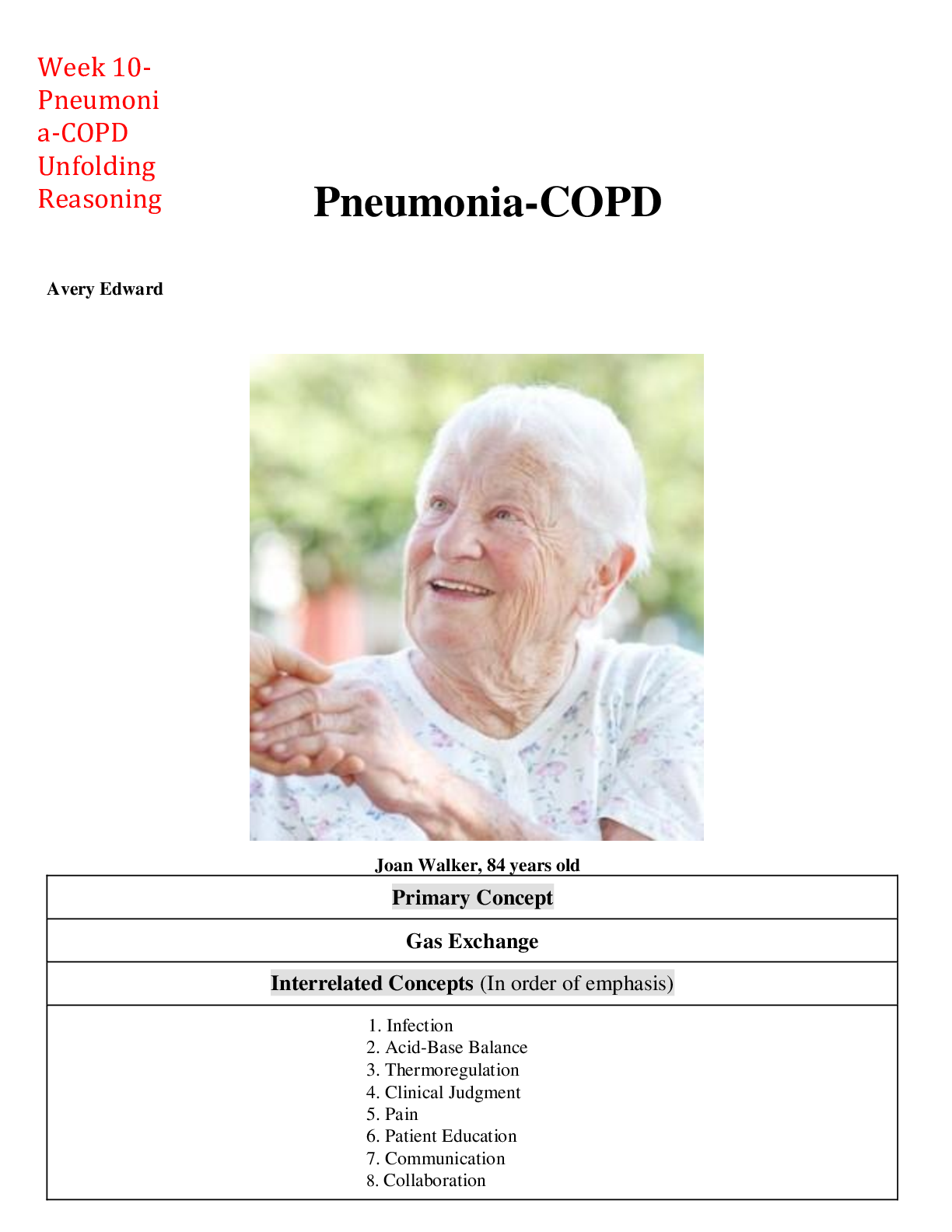
Reviews( 0 )
Document information
Connected school, study & course
About the document
Uploaded On
Oct 13, 2022
Number of pages
16
Written in
Additional information
This document has been written for:
Uploaded
Oct 13, 2022
Downloads
0
Views
42


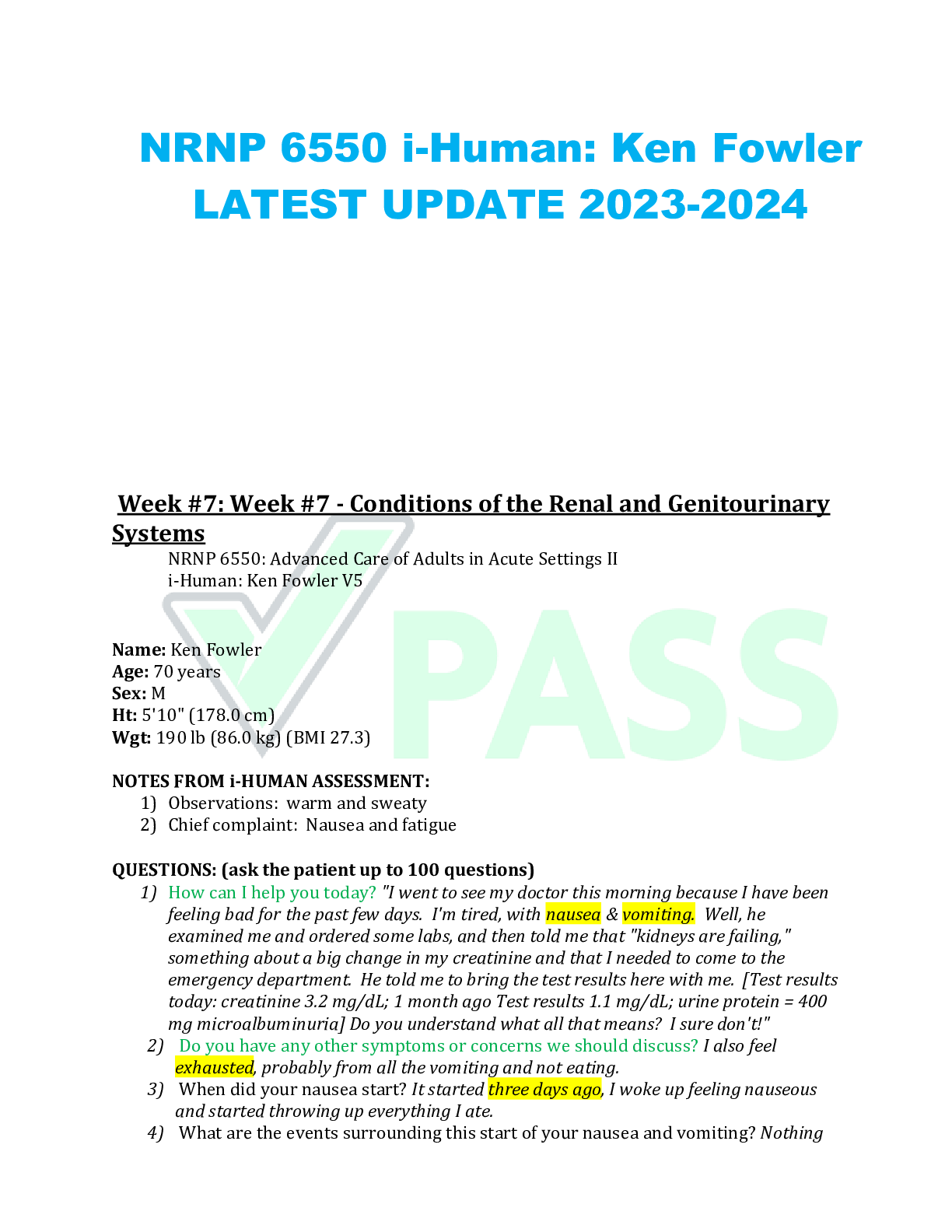
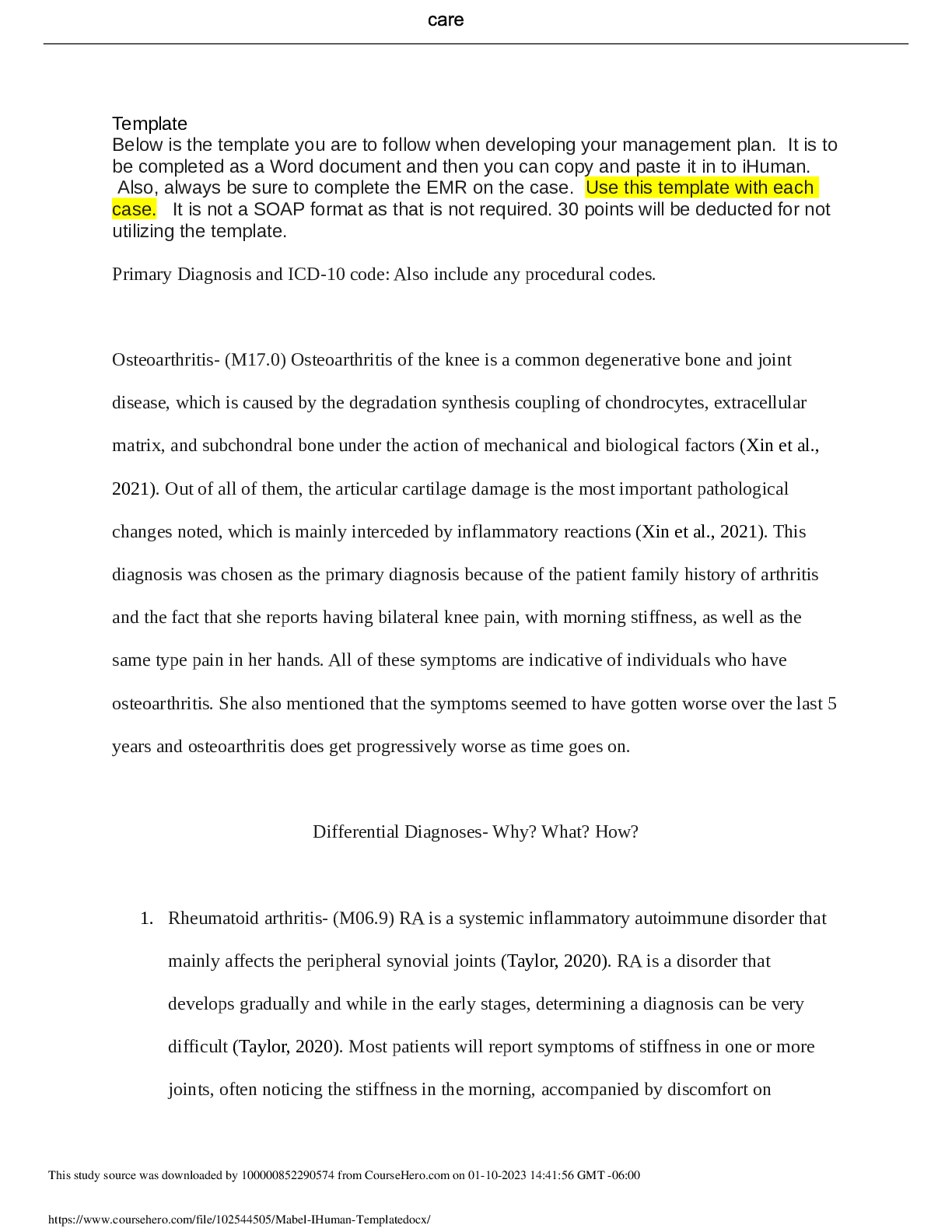



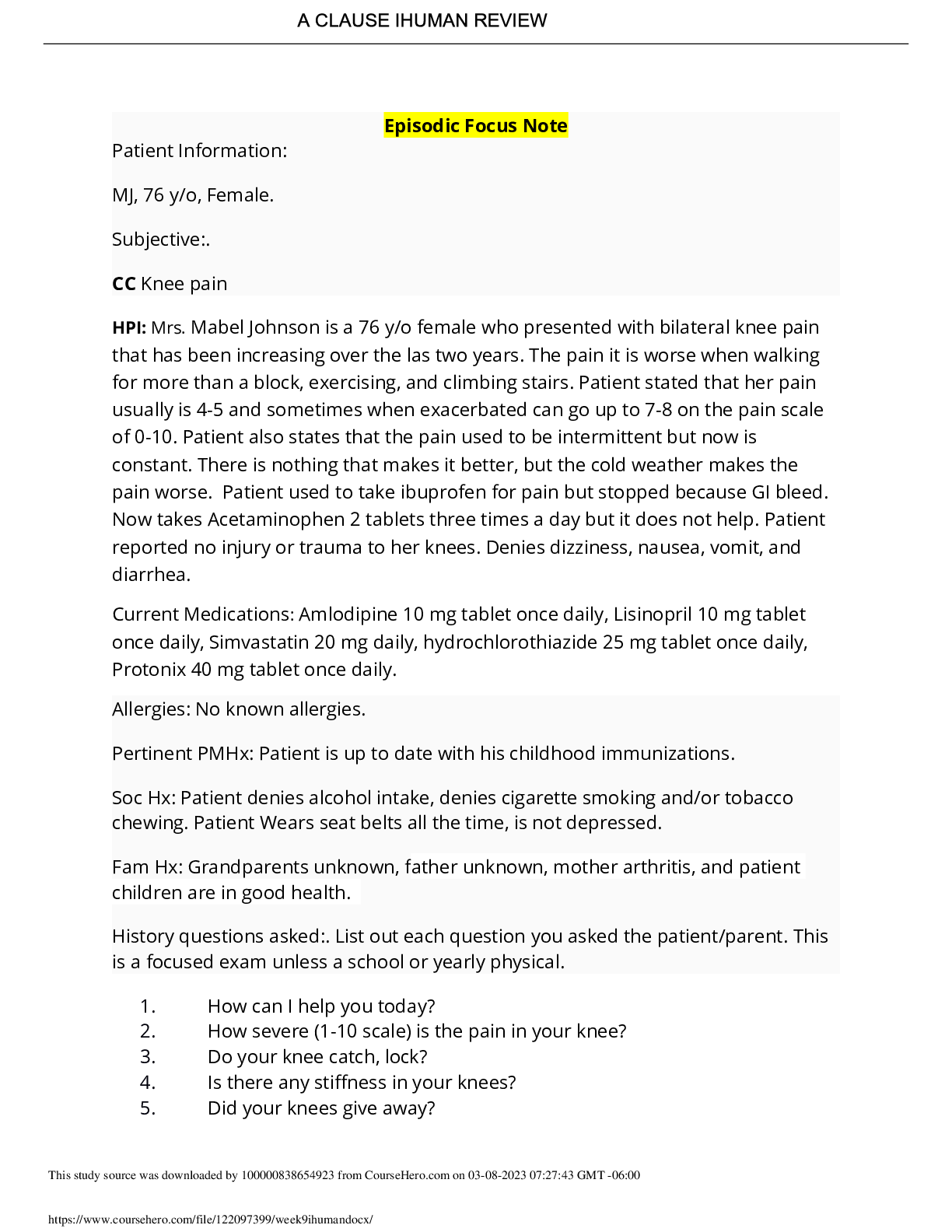
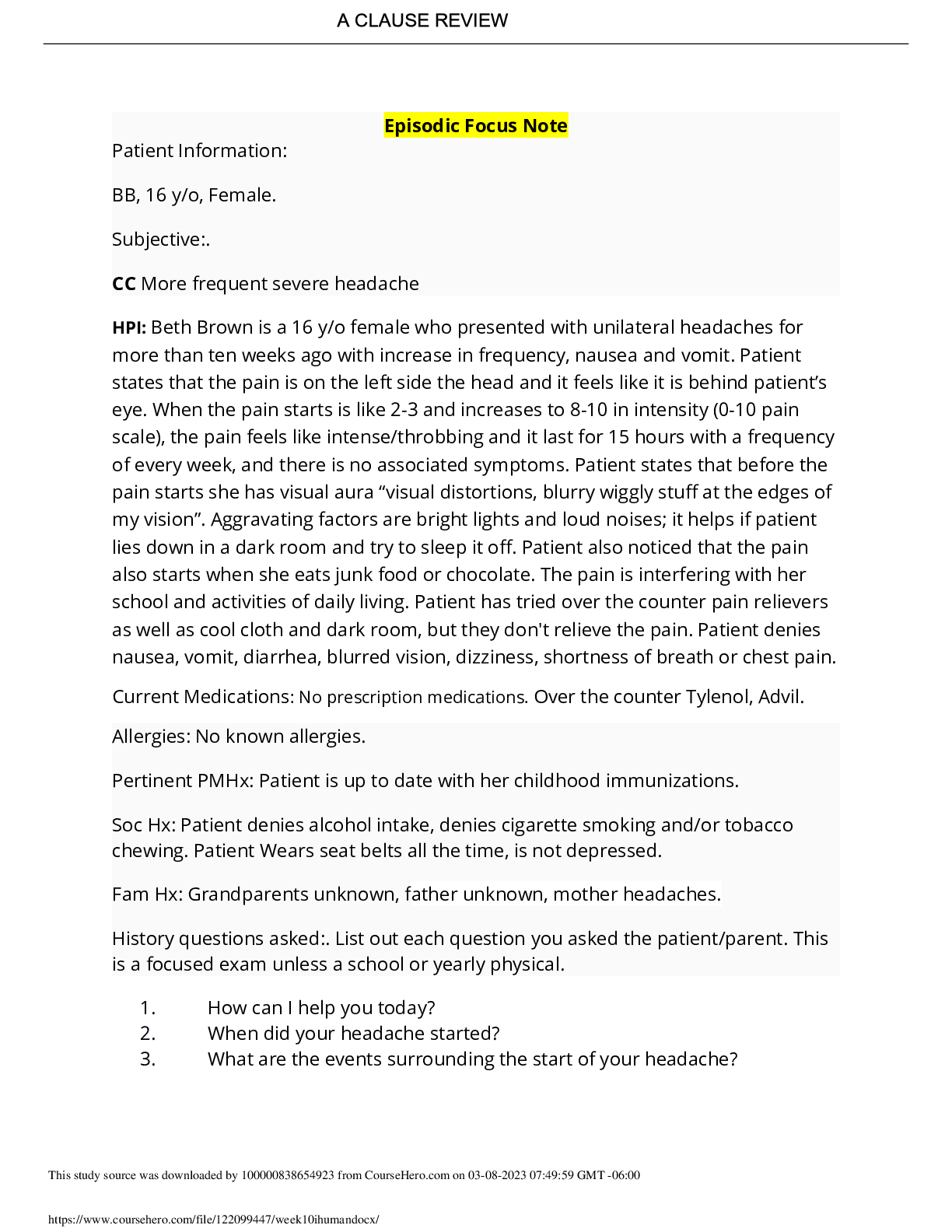


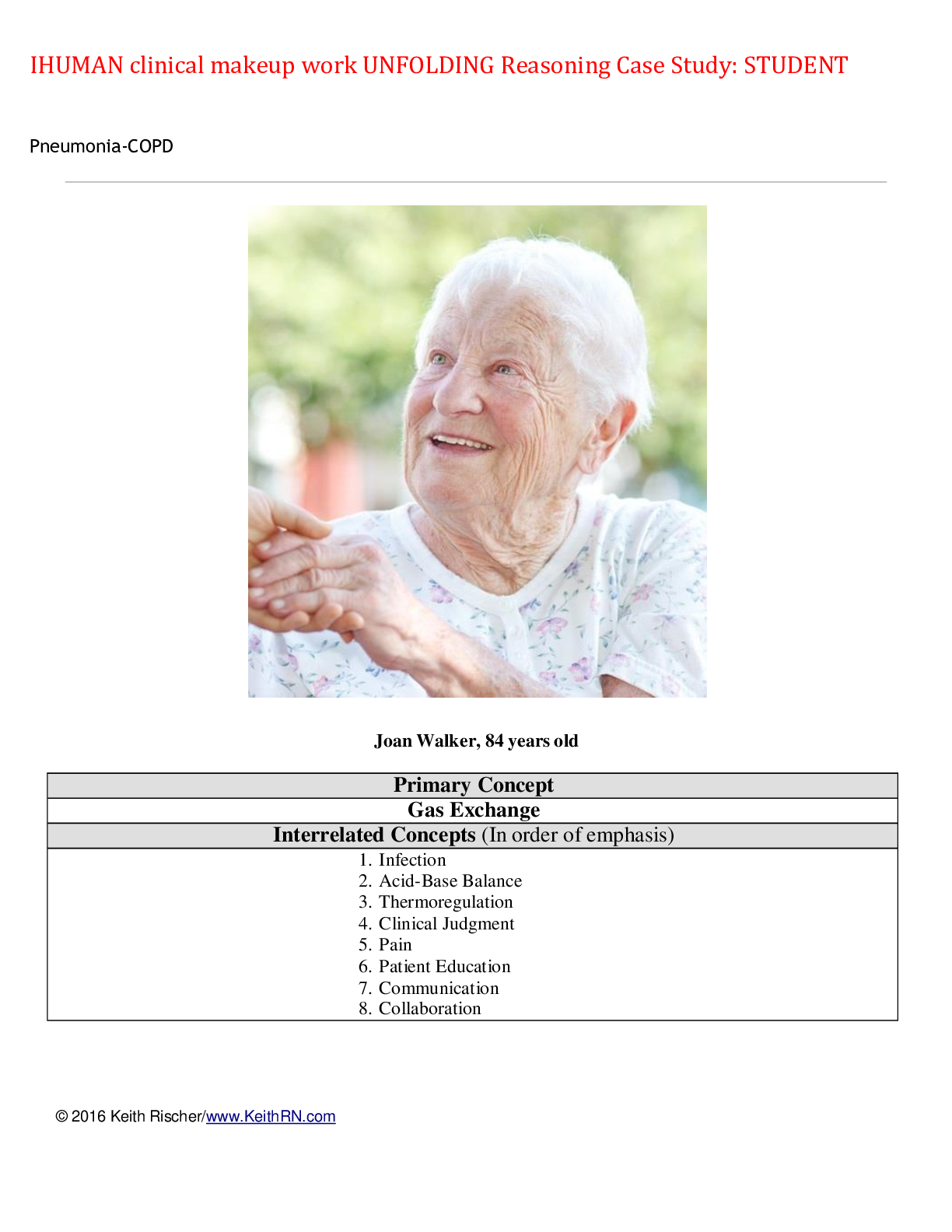
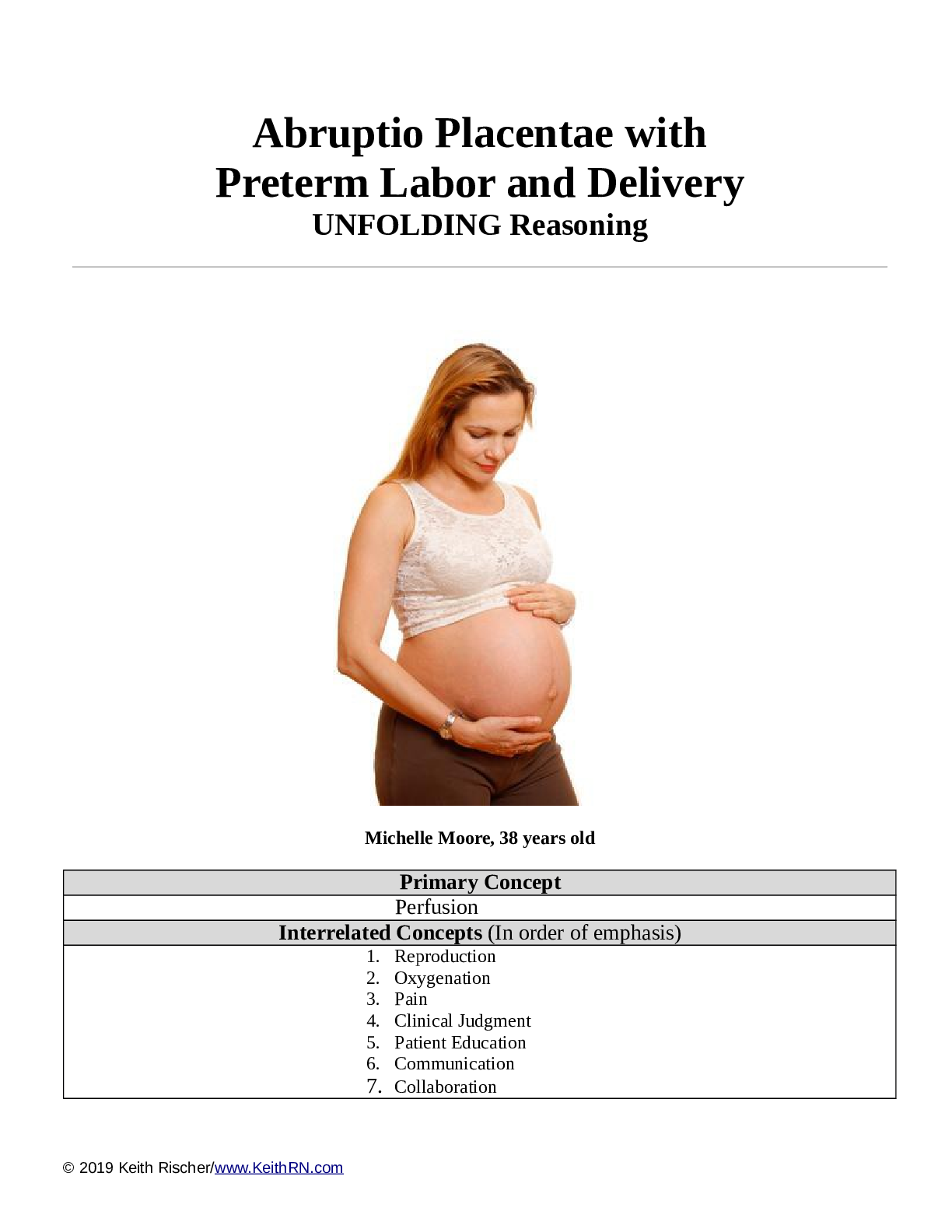
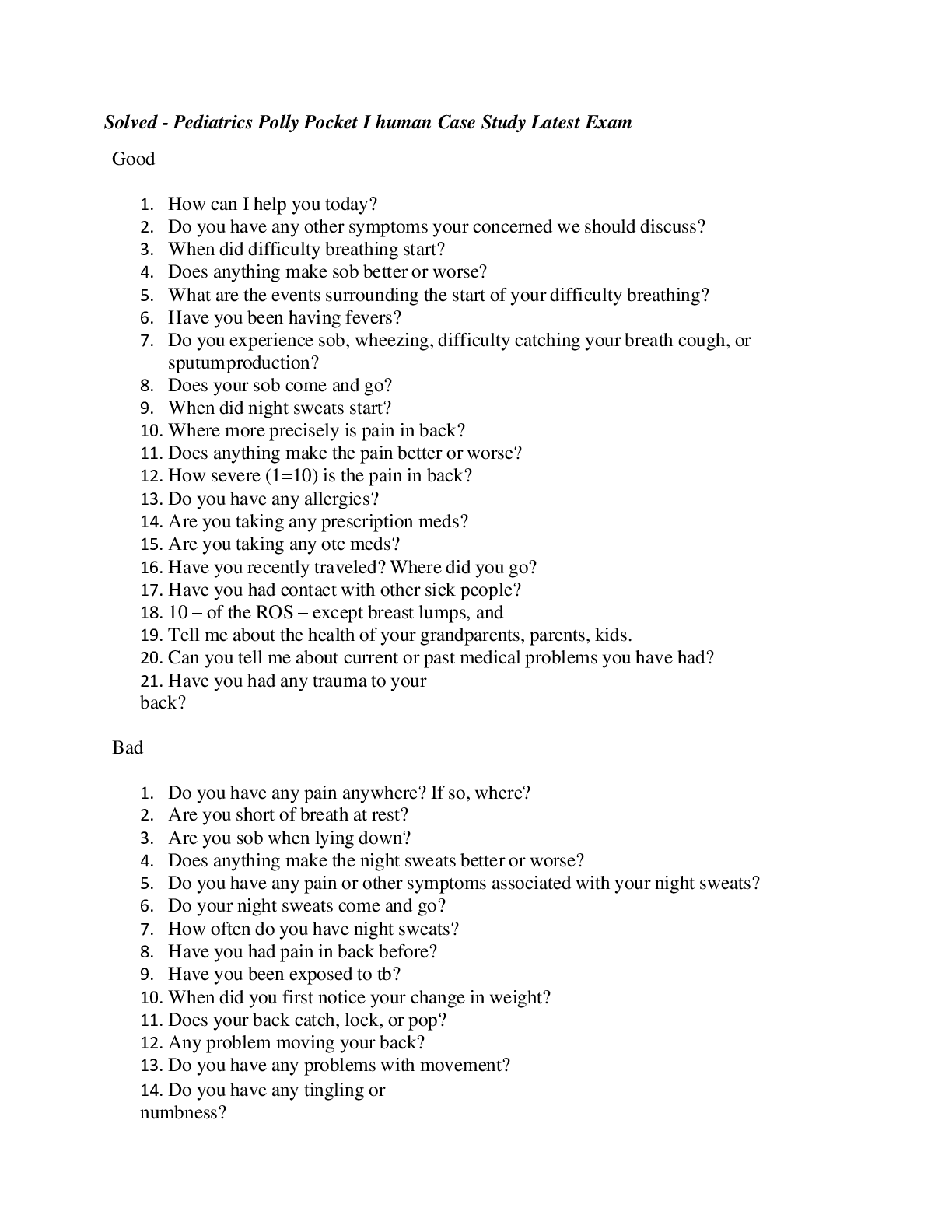


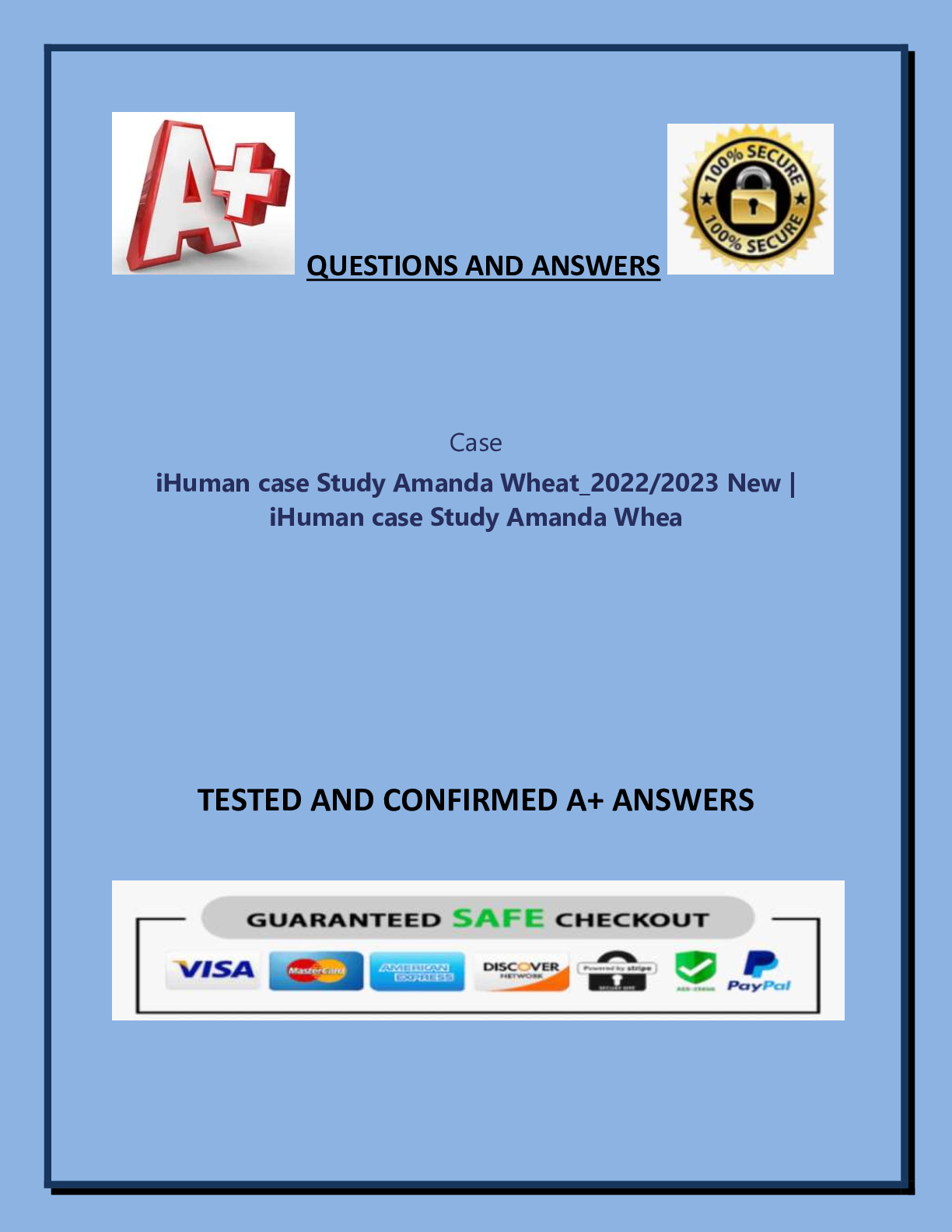
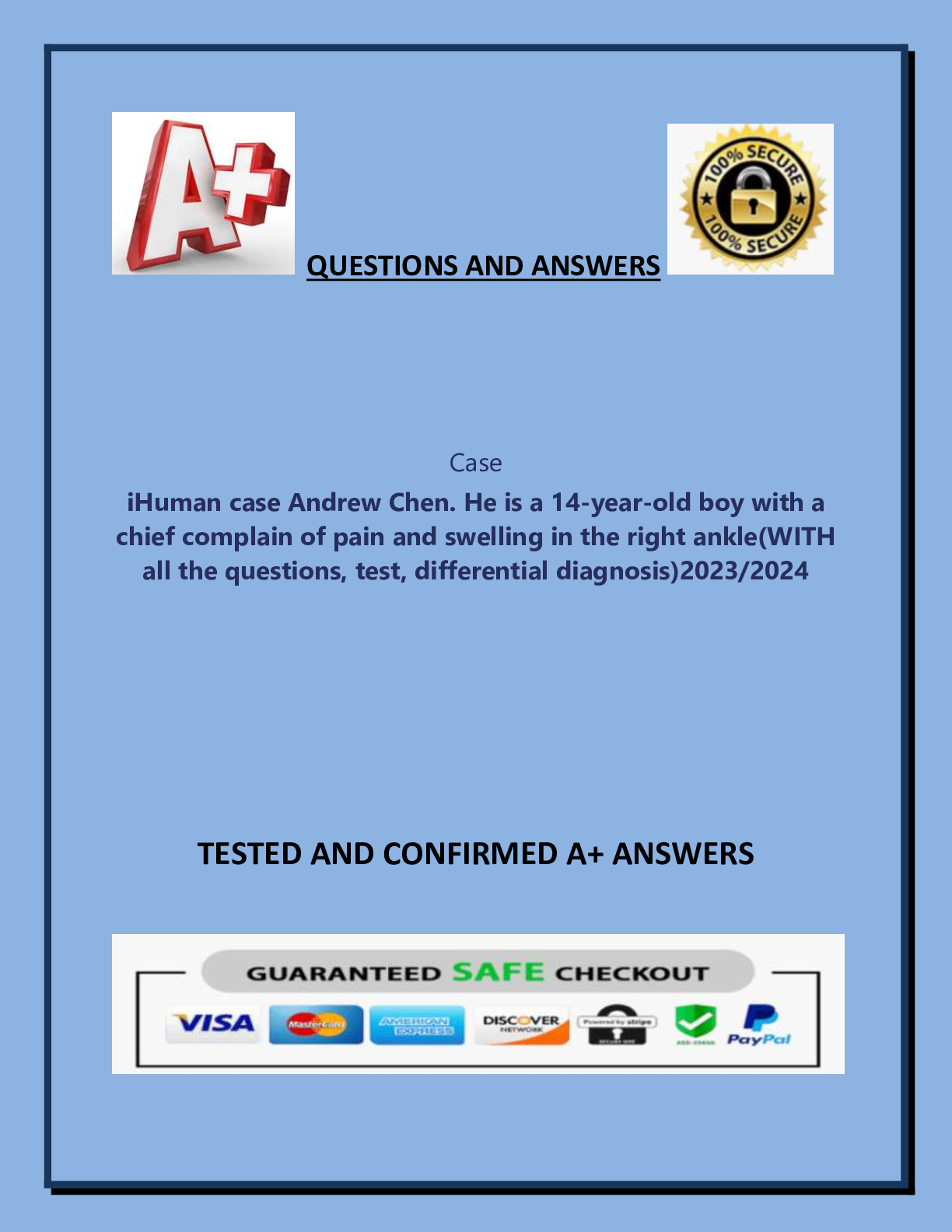
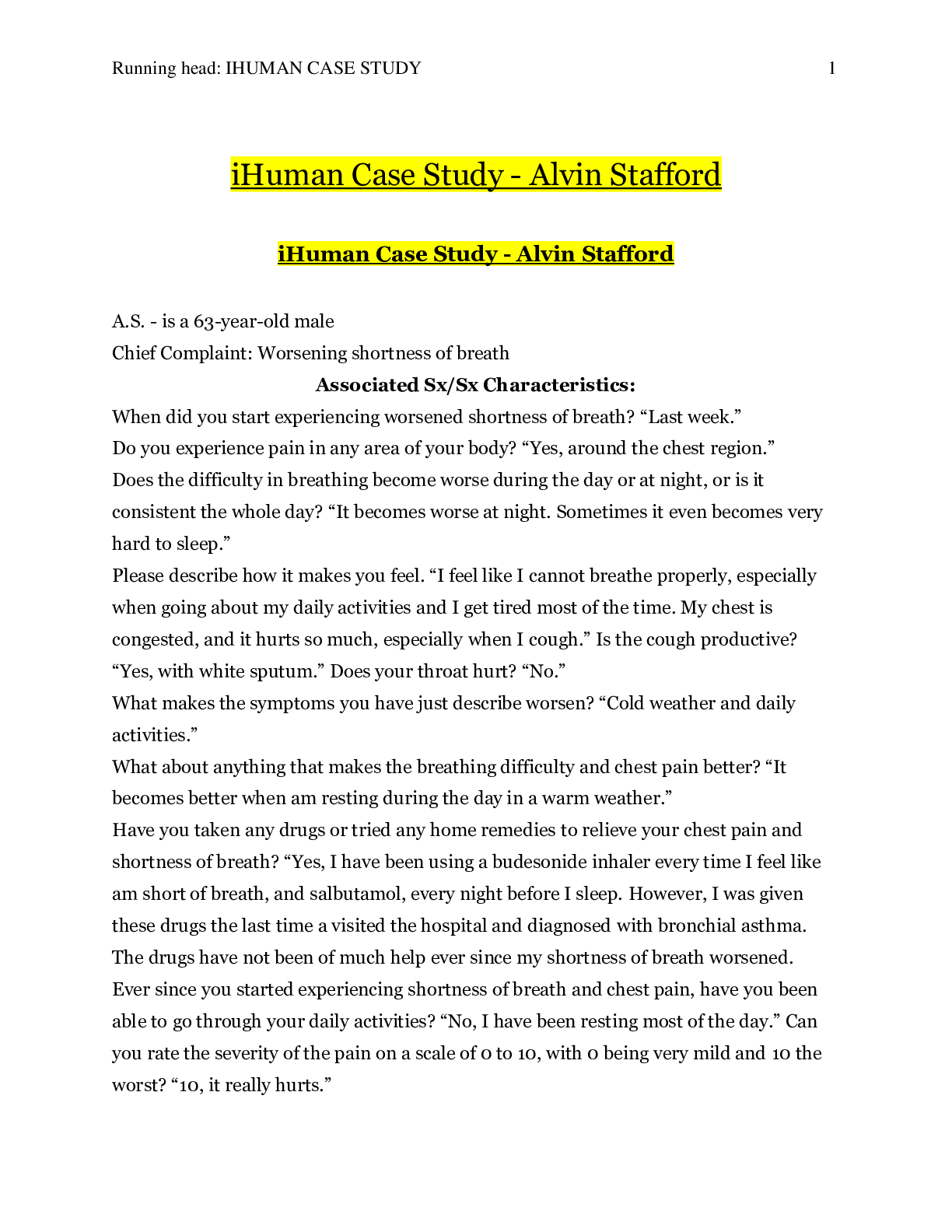
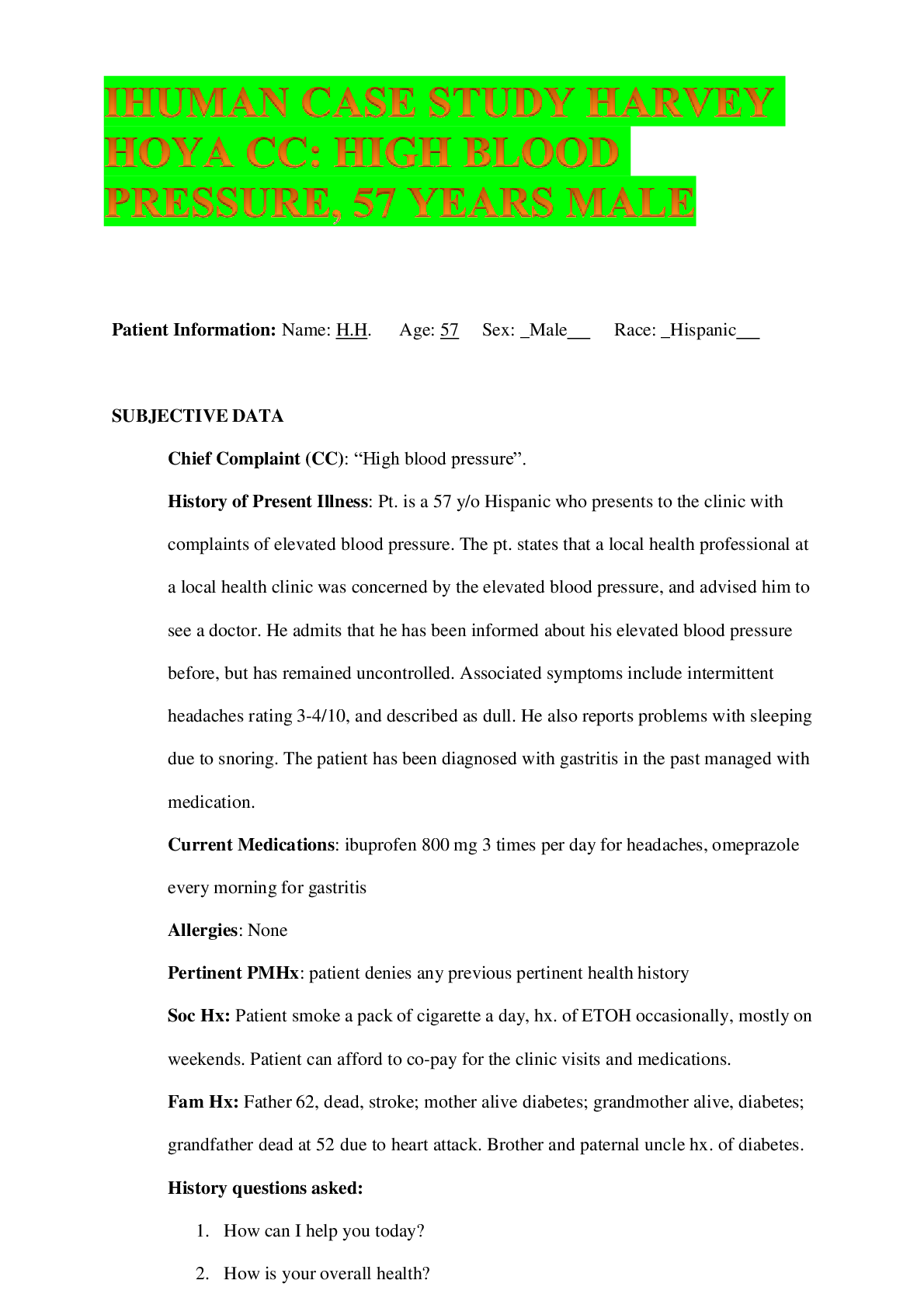
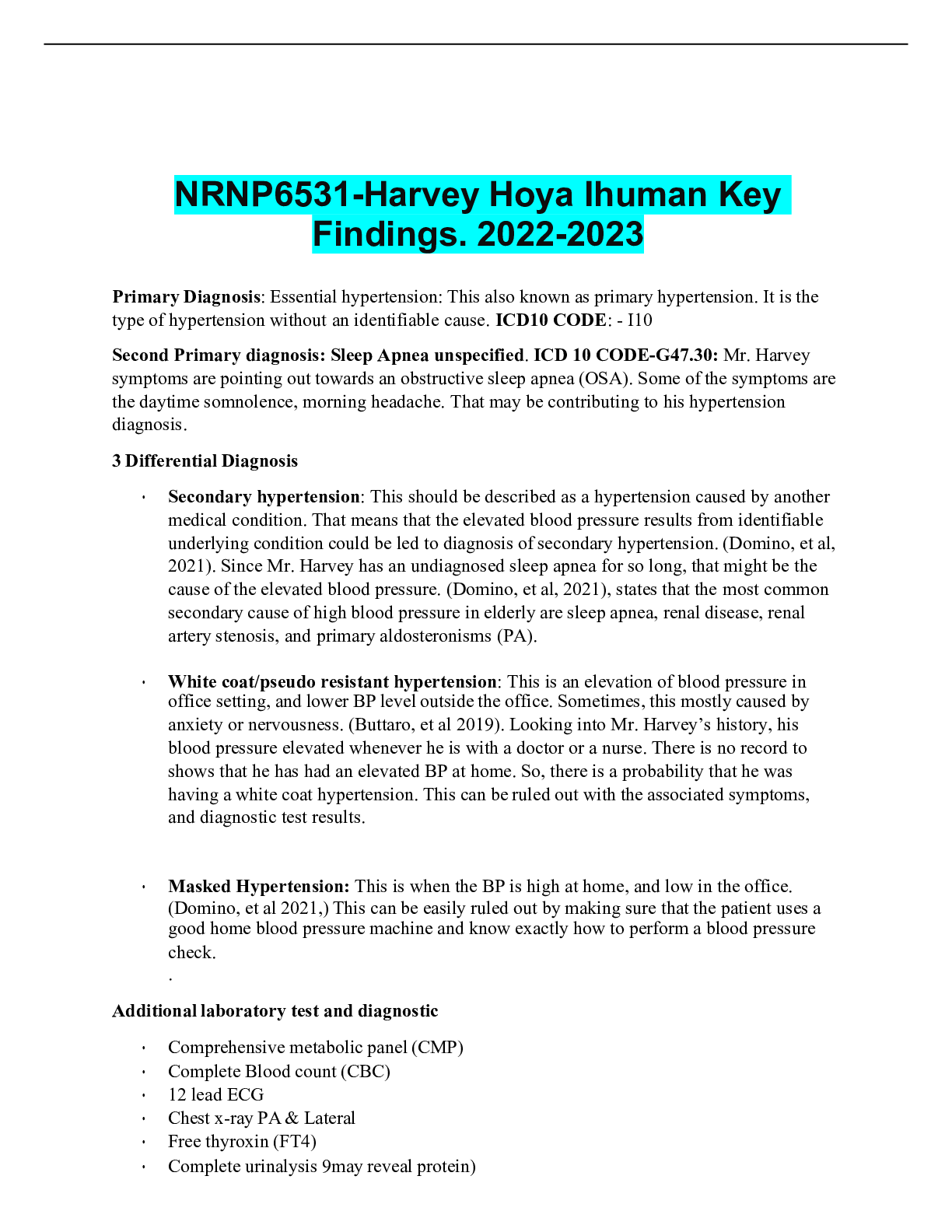
 2021.png)


